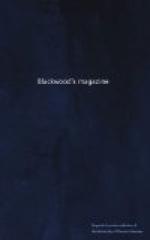“The only time Scotch farm-servants indulge in butcher-meat is when a sheep falls, as it is termed; that is, when it is killed before being affected with an unwholesome disease, and the mutton is sold at a reduced price. Shred down the suet small, removing any flesh or cellular membrane adhering to it; then mix amongst it intimately 1/2 oz. of salt and a tea-spoonful of pepper to every pound of suet; put the mixture into an earthen jar, and tie up tightly with bladder. One table spoonful of seasoned suet will, at any time, make good barley-broth or potato-soup for two persons. The lean of the mutton may be shred down small, and seasoned in a similar manner, and used when required; or it may be corned with salt, and used as a joint.” —Vol. ii. p. 105.
How much of the natural habits and manners of a country, and of the circumstances and inner life of the various classes of its inhabitants, is to be learned from a study of their cookery!
Reader, what a mystery hangs over the handling of a fat beast! A feeder approaches a well filled short-horn—he touches it here—he pinches it there—he declares it to have many good points about it; but pronounces the existence of defects, where the uninitiated see only beauties. The points of a fat ox, how mysterious they are, how difficult to make out! The five points of Arminianism, our old vicar used to say, were nothing to them. But here, too, Mr. Stephens is at home. Listen to his simple explanation of the whole:
“The first point usually handled is the end of the rump at the tail-head, although any fat here is very obvious, and sometimes attains to an enormous size, amounting even to deformity. The hook-bone gets a touch, and when well covered, is right.... To the hand, or rather to the points of the fingers of the right hand, when laid upon the ribs, the flesh should feel soft and thick and the form be round when all is right, but if the ribs are flat the flesh will feel hard and thin from want of fat. The skin, too, on a rounded rib, will feel soft and mobile, the hair deep and mossy, both indicative of a kindly disposition to lay on flesh. The hand then grasps the flank, and finds it thick, when the existence of internal tallow is indicated.... The palm of the hand laid along the line of the back will point out any objectionable hard piece on it, but if all is soft and pleasant, then the shoulder-top is good. A hollowness behind the shoulder is a very common occurrence; but when it is filled up with a layer of fat, the flesh of all the fore-quarter is thereby rendered very much more valuable. You would scarcely believe that such a difference could exist in the flesh between a lean and a fat shoulder. A high narrow shoulder is frequently attended with a ridged back-bone, and lowset narrow hooks, a form which gets the appropriate name of razor-back, with which will always be found a deficiency of flesh in all the upper part




